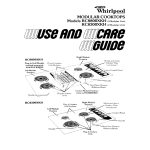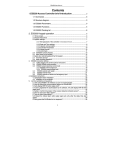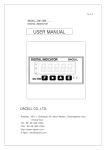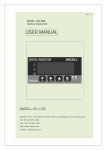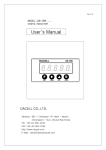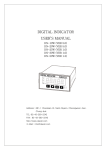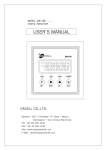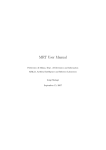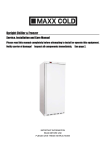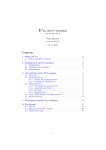Download USER`S MANUAL
Transcript
MODEL : AM-1000 DYNAMIC STRAIN AMPLIFIER USER’S MANUAL DACELL CO.,LTD. Address: 681-1, Cheoksan-Ri, Nami-Myeon, Cheongweon-Gun, Chung-Buk, 363-810 Korea TEL: 82-43-260-2242 FAX: 82-43-260-2245 http://www.dacell.com E-Mail: [email protected] CONTENTS 1. FOREWORD ⋅⋅⋅⋅⋅⋅⋅⋅⋅⋅⋅⋅⋅⋅⋅⋅⋅⋅⋅⋅⋅⋅⋅⋅⋅⋅⋅⋅⋅⋅⋅⋅⋅⋅⋅⋅⋅⋅⋅⋅⋅⋅⋅⋅⋅⋅⋅⋅⋅⋅⋅⋅⋅⋅⋅⋅⋅⋅⋅⋅⋅⋅⋅⋅⋅⋅⋅⋅⋅⋅⋅⋅⋅⋅⋅⋅⋅⋅⋅⋅⋅⋅⋅⋅⋅⋅⋅⋅⋅⋅⋅⋅⋅⋅⋅⋅⋅⋅⋅⋅⋅⋅⋅⋅⋅⋅⋅⋅⋅⋅⋅⋅⋅⋅⋅⋅⋅ 2 2. SPECIFICATION ⋅⋅⋅⋅⋅⋅⋅⋅⋅⋅⋅⋅⋅⋅⋅⋅⋅⋅⋅⋅⋅⋅⋅⋅⋅⋅⋅⋅⋅⋅⋅⋅⋅⋅⋅⋅⋅⋅⋅⋅⋅⋅⋅⋅⋅⋅⋅⋅⋅⋅⋅⋅⋅⋅⋅⋅⋅⋅⋅⋅⋅⋅⋅⋅⋅⋅⋅⋅⋅⋅⋅⋅⋅⋅⋅⋅⋅⋅⋅⋅⋅⋅⋅⋅⋅⋅⋅⋅⋅⋅⋅⋅⋅⋅⋅⋅⋅⋅⋅⋅⋅⋅⋅⋅⋅⋅⋅⋅⋅⋅ 3 3. COMPOSITION ⋅⋅⋅⋅⋅⋅⋅⋅⋅⋅⋅⋅⋅⋅⋅⋅⋅⋅⋅⋅⋅⋅⋅⋅⋅⋅⋅⋅⋅⋅⋅⋅⋅⋅⋅⋅⋅⋅⋅⋅⋅⋅⋅⋅⋅⋅⋅⋅⋅⋅⋅⋅⋅⋅⋅⋅⋅⋅⋅⋅⋅⋅⋅⋅⋅⋅⋅⋅⋅⋅⋅⋅⋅⋅⋅⋅⋅⋅⋅⋅⋅⋅⋅⋅⋅⋅⋅⋅⋅⋅⋅⋅⋅⋅⋅⋅⋅⋅⋅⋅⋅⋅⋅⋅⋅⋅⋅⋅⋅⋅⋅⋅⋅⋅⋅ 6 3-1. FRONT PANEL ⋅⋅⋅⋅⋅⋅⋅⋅⋅⋅⋅⋅⋅⋅⋅⋅⋅⋅⋅⋅⋅⋅⋅⋅⋅⋅⋅⋅⋅⋅⋅⋅⋅⋅⋅⋅⋅⋅⋅⋅⋅⋅⋅⋅⋅⋅⋅⋅⋅⋅⋅⋅⋅⋅⋅⋅⋅⋅⋅⋅⋅⋅⋅⋅⋅⋅⋅⋅⋅⋅⋅⋅⋅⋅⋅⋅⋅⋅⋅⋅⋅⋅⋅⋅⋅⋅⋅⋅⋅⋅⋅⋅⋅⋅⋅⋅⋅⋅⋅⋅⋅⋅⋅⋅⋅⋅⋅ 6 3-2. BACK PANAL ⋅⋅⋅⋅⋅⋅⋅⋅⋅⋅⋅⋅⋅⋅⋅⋅⋅⋅⋅⋅⋅⋅⋅⋅⋅⋅⋅⋅⋅⋅⋅⋅⋅⋅⋅⋅⋅⋅⋅⋅⋅⋅⋅⋅⋅⋅⋅⋅⋅⋅⋅⋅⋅⋅⋅⋅⋅⋅⋅⋅⋅⋅⋅⋅⋅⋅⋅⋅⋅⋅⋅⋅⋅⋅⋅⋅⋅⋅⋅⋅⋅⋅⋅⋅⋅⋅⋅⋅⋅⋅⋅⋅⋅⋅⋅⋅⋅⋅⋅⋅⋅⋅⋅⋅⋅⋅⋅ 7 3-3. DESCRIPTION ……………⋅⋅⋅⋅⋅⋅⋅⋅⋅⋅⋅⋅⋅⋅⋅⋅⋅⋅⋅⋅⋅⋅⋅⋅⋅⋅⋅⋅⋅⋅⋅⋅⋅⋅⋅⋅⋅⋅⋅⋅⋅⋅⋅⋅⋅⋅⋅⋅⋅⋅⋅⋅⋅⋅⋅⋅⋅⋅⋅⋅⋅⋅ 8 4. HOW TO OPERATE ⋅⋅⋅⋅⋅⋅⋅⋅⋅⋅⋅⋅⋅⋅⋅⋅⋅⋅⋅⋅⋅⋅⋅⋅⋅⋅⋅⋅⋅⋅⋅⋅⋅⋅⋅⋅⋅⋅⋅⋅⋅⋅⋅⋅⋅⋅⋅⋅⋅⋅⋅⋅⋅⋅⋅⋅⋅⋅⋅⋅⋅⋅⋅⋅⋅⋅⋅⋅⋅⋅⋅⋅⋅⋅⋅⋅⋅⋅⋅⋅⋅⋅⋅⋅⋅⋅⋅⋅⋅⋅⋅⋅⋅⋅⋅⋅⋅⋅⋅⋅⋅⋅⋅⋅⋅⋅⋅⋅ 11 4-1. POWER CONNECTION⋅⋅⋅⋅⋅⋅⋅⋅⋅⋅⋅⋅⋅⋅⋅⋅⋅⋅⋅⋅⋅⋅⋅⋅⋅⋅⋅⋅⋅⋅⋅⋅⋅⋅⋅⋅⋅⋅⋅⋅⋅⋅⋅⋅⋅⋅⋅⋅⋅⋅⋅⋅⋅⋅⋅⋅⋅⋅⋅⋅⋅⋅⋅⋅⋅⋅⋅⋅⋅⋅⋅⋅⋅⋅⋅⋅⋅⋅⋅⋅⋅⋅⋅⋅⋅⋅⋅⋅⋅⋅⋅⋅⋅⋅⋅⋅11 4-2. SENSOR CONNECTION ⋅⋅⋅⋅⋅⋅⋅⋅⋅⋅⋅⋅⋅⋅⋅⋅⋅⋅⋅⋅⋅⋅⋅⋅⋅⋅⋅⋅⋅⋅⋅⋅⋅⋅⋅⋅⋅⋅⋅⋅⋅⋅⋅⋅⋅⋅⋅⋅⋅⋅⋅⋅⋅⋅⋅⋅⋅⋅⋅⋅⋅⋅⋅⋅⋅⋅⋅⋅⋅⋅⋅⋅⋅⋅⋅⋅⋅⋅⋅⋅⋅⋅⋅⋅⋅⋅⋅ 11 4-3. INPUT HIGH LEVEL VOLTAGE⋅⋅⋅⋅⋅⋅⋅⋅⋅⋅⋅⋅⋅⋅⋅⋅⋅⋅⋅⋅⋅⋅⋅⋅⋅⋅⋅⋅⋅⋅⋅⋅⋅⋅⋅⋅⋅⋅⋅⋅⋅⋅⋅⋅⋅⋅⋅⋅⋅⋅⋅⋅⋅⋅⋅⋅⋅⋅⋅⋅⋅⋅⋅⋅⋅⋅⋅⋅⋅⋅⋅⋅⋅⋅⋅⋅⋅⋅⋅⋅⋅ 14 4-4. NOTES FOR SELECTING SENSOR CABLE ⋅⋅⋅⋅⋅⋅⋅⋅⋅⋅⋅⋅⋅⋅⋅⋅⋅⋅⋅⋅⋅⋅⋅⋅⋅⋅⋅⋅⋅⋅⋅⋅⋅⋅⋅⋅⋅⋅⋅⋅⋅⋅⋅⋅⋅⋅⋅⋅⋅⋅⋅⋅⋅⋅⋅⋅⋅⋅ 14 4-5. NOTES FOR DYNAMIC MEASUREMENT ⋅⋅⋅⋅⋅⋅⋅⋅⋅⋅⋅⋅⋅⋅⋅⋅⋅⋅⋅⋅⋅⋅⋅⋅⋅⋅⋅⋅⋅⋅⋅⋅⋅⋅⋅⋅⋅⋅⋅⋅⋅⋅⋅⋅⋅⋅⋅⋅⋅⋅⋅⋅⋅⋅⋅⋅⋅⋅⋅⋅⋅⋅ 14 4-6. NOTES FOR STATIC MEASUREMENT⋅⋅⋅⋅⋅⋅⋅⋅⋅⋅⋅⋅⋅⋅⋅⋅⋅⋅⋅⋅⋅⋅⋅⋅⋅⋅⋅⋅⋅⋅⋅⋅⋅⋅⋅⋅⋅⋅⋅⋅⋅⋅⋅⋅⋅⋅⋅⋅⋅⋅⋅⋅⋅⋅⋅⋅⋅⋅⋅⋅⋅⋅⋅⋅⋅⋅⋅⋅ 15 4-7. Output CONNECTION⋅⋅⋅⋅⋅⋅⋅⋅⋅⋅⋅⋅⋅⋅⋅⋅⋅⋅⋅⋅⋅⋅⋅⋅⋅⋅⋅⋅⋅⋅⋅⋅⋅⋅⋅⋅⋅⋅⋅⋅⋅⋅⋅⋅⋅⋅⋅⋅⋅⋅⋅⋅⋅⋅⋅⋅⋅⋅⋅⋅⋅⋅⋅⋅⋅⋅⋅⋅⋅⋅⋅⋅⋅⋅⋅⋅⋅⋅⋅⋅⋅⋅⋅⋅⋅⋅⋅⋅⋅⋅⋅⋅⋅⋅⋅⋅ 15 4-8. CONTROLLING PROPER SENSOR VOLTAGE⋅⋅⋅⋅⋅⋅⋅⋅⋅⋅⋅⋅⋅⋅⋅⋅⋅⋅⋅⋅⋅⋅⋅⋅⋅⋅⋅⋅⋅⋅⋅⋅⋅⋅⋅⋅⋅⋅⋅⋅⋅⋅⋅⋅⋅⋅⋅⋅⋅⋅⋅⋅⋅⋅ 15 4-9. BRIDGE BALANCE⋅⋅⋅⋅⋅⋅⋅⋅⋅⋅⋅⋅⋅⋅⋅⋅⋅⋅⋅⋅⋅⋅⋅⋅⋅⋅⋅⋅⋅⋅⋅⋅⋅⋅⋅⋅⋅⋅⋅⋅⋅⋅⋅⋅⋅⋅⋅⋅⋅⋅⋅⋅⋅⋅⋅⋅⋅⋅⋅⋅⋅⋅⋅⋅⋅⋅⋅⋅⋅⋅⋅⋅⋅⋅⋅⋅⋅⋅⋅⋅⋅⋅⋅⋅⋅⋅⋅⋅⋅⋅⋅⋅⋅⋅⋅⋅⋅⋅⋅⋅⋅⋅ 16 4-10. GAIN CONTROL ⋅⋅⋅⋅⋅⋅⋅⋅⋅⋅⋅⋅⋅⋅⋅⋅⋅⋅⋅⋅⋅⋅⋅⋅⋅⋅⋅⋅⋅⋅⋅⋅⋅⋅⋅⋅⋅⋅⋅⋅⋅⋅⋅⋅⋅⋅⋅⋅⋅⋅⋅⋅⋅⋅⋅⋅⋅⋅⋅⋅⋅⋅⋅⋅⋅⋅⋅⋅⋅⋅⋅⋅⋅⋅⋅⋅⋅⋅⋅⋅⋅⋅⋅⋅⋅⋅⋅⋅⋅⋅⋅⋅⋅⋅⋅⋅⋅⋅⋅⋅⋅⋅⋅ 16 4-11. FILTER CONTROL⋅⋅⋅⋅⋅⋅⋅⋅⋅⋅⋅⋅⋅⋅⋅⋅⋅⋅⋅⋅⋅⋅⋅⋅⋅⋅⋅⋅⋅⋅⋅⋅⋅⋅⋅⋅⋅⋅⋅⋅⋅⋅⋅⋅⋅⋅⋅⋅⋅⋅⋅⋅⋅⋅⋅⋅⋅⋅⋅⋅⋅⋅⋅⋅⋅⋅⋅⋅⋅⋅⋅⋅⋅⋅⋅⋅⋅⋅⋅⋅⋅⋅⋅⋅⋅⋅⋅⋅⋅⋅⋅⋅⋅⋅⋅⋅⋅⋅⋅⋅⋅ 17 1 1. FOREWORD Dynamic Strain Amplifier DN-AM1000 is composed as the following features. • This device amplifies minute voltage signals of strain gauge type sensor or all types of transducer to display and output as in voltage. • Shunt CAL feature is installed. • Electronic Auto Zero Balance method is used for Zero Span. • This device can use connection for Quarter, Half, Full bridge type of gauge • It is designed to install on standard 19” Sub rack. 2. SPECIFICATION 1 Measurement marks ○ : 1CH / EA 2 Measuring method ○ ③ Working Gauge ④ Gauge rate ⑤ Bridge voltage (B.V/V) : Deflection Method : 120Ω, 350Ω : 2.00 : DC 1V, 2V, 5V, 7.5V, 10V ⑥ Measuring range Bridge Voltage Measuring range 10V…………………… 2000 µstrain 5V…………………… 4000 µstrain 2V…………………… 10000 µstrain ⑦ Zero adjustment range Auto - ± 10 % Zero - ± 1 % 2 strain ⑧ Equilibrium control method Automatic equilibrium control (Auto) –Extent : ± 4000µstrain Time : about 1 second Back up : semi-perma-nent. : ± 1V Passivity fine control (Zero ADJ) 9 ○ Max. Sensitivity (At 100µstrain input) Bridge Voltage Output 10V…………………… 5V 5V…………………… 2.5V 2V…………………… 1V 10 Output ○ OUT1 OUT2 : ± 10V (more than 200Ω load) : ± 10V (more than 2kΩ load) 11 Non-linearity ○ 12 Calibration ○ Extent : 1.0mV/V : 0.1mV/V : : ± 0.01% F.S (CAL) 1% F.S 2000µstrain 200µstrain 13 Sensitivity adjustment (GAIN) ○ X1, X10,X100,X400, X1000 within ± 1% at error each point (SPAN) X1 ~ X11 continuous variableness (FINE) X1 ~ X2 continuous variableness 14 S/N 비 (Input conversion numerical value) ○ CMRR (Input conversion numerical value) : more than 54dB (1kHz) : more than 100dB (1kHz) 15 Response frequency characteristic ○ DC~100kHz (GAIN : 1000, Reduction : -3dB) DC~20kHz (GAIN : 1000, Reduction : -0.1dB) 16 Low Pass Filter ○ (L.P.F) Frequency: 10, 100, 1K, 10K, PASS 5 stages About decrease : within -6dB/oct 3 17 Temperature range for use ○ 0 ~ +60°C 18 Effect by temperature change ○ Zero drift : within ± 1 µstrain/°C Sensitivity change: ± 0.03% F.S/°C 19 Effect by electric power change (About ± 10% change in supply voltage) ○ Zero drift: within ± 0.05% F.S Sensitivity change: within ± 0.05% F.S 20 MONITOR : Digital Voltage Display ○ Over 10V will be displayed in 10.00 (increased or decreased in each 0.01) Less 10V will be displayed in 0.000 (increased or decreased in each 0.001) Voltage on OUT1 will be displayed in Digital. 21 Supply Voltage ○ AC100/220V ± 10% 60Hz 22 External Size and Weight ○ 128.4 (H) × 43.2 (W) × 198 (D) mm 1000g 23 OPTION ○ Output: OUT1 ± 100mA output 4 3. Composition 3-1. Front Panel 1 Symbol (-) display ○ 2 Voltage display ○ 3 Zero hand-operated control volume ○ 4 Zero auto control switch ○ 5 L.P.F switch ○ 6 Bridge voltage selecting switch ○ 7 Bridge voltage fine control volume ○ 8 ○ Bridge voltage senscing selecting switch 9 ○ Internal CAL Bridge resistance selecting switch 10 CAL Strain value switch ○ 11 GAIN selecting switch ○ 12 GAIN control volume ○ 13 GAIN fine control volume ○ 14 Power lamp ○ 15 Power switch ○ 16 Sensor input voltage monitor terminal ○ 17 ○ Sensor output voltage terminal 18 Signal output monitor terminal ○ 5 monitor 3-2.Back Panel 19 ○ 20 ○ 21 ○ 22 ○ 23 ○ 24 ○ 25 ○ Low-current output (load more than 2kΩ) High-current output (load more than 200Ω) Sensor input connector Case earth terminal Fuse Power selecting switch Power input connector 6 3-3. Description 1 Symbol (-) display ○ This symbol lamp will be lighted when the output voltage is become less than 0V. 2 Voltage display ○ Output voltage is displayed as in 4 Digit -7 Segment LED. When output voltage is over 10V or below -10V, it will be displayed as +/10.00 and the rest section will be displayed as in +/- 9.000V. 3 Zero Hand-operated control volume ○ It is a volume to control the offset of residual quantity after finishing the auto zero control. Control range is within ± 1V. 4 Zero auto control switch ○ Use this switch to carry out auto zero control. When this auto switch is pressed, “Auto” will appear on the LED and then zero will be set. 6 Bridge voltage selecting switch ○ This switch is to select the bridge supply voltage. You can make your selection for the supply voltage among DC 1V, 2V, 5V, 7.5V, 10V. 7 Bridge voltage fine control volume ○ This controls establishing bridge voltage precisely. 8 Bridge voltage senscing selecting switch ○ When select by EXT mode as switch to compensate bridge voltage by Cable's resistance change, bridge voltage by Cable length change moves automatically and is corrected. 9 Internal CAL Bridge resistance selecting switch ○ This switch is to select the bridge resistance while you are doing bridge calibration. 10 CAL Strain value switch ○ It is a shunt switch to calibrate the bridge in two different types - 2000µ and 200µstrain. 11 GAIN selecting switch ○ 7 It is the switch to control GAIN and it can be controlled as in X1, X10, X100, X400, X1000 times. 12 GAIN control volume ○ It is a volume to control GAIN and it can be continuously controlled as in 을 from X1 up to X11 times. 13 GAIN fine control volume ○ It is a volume for the fine control of GAIN. It can be continuously controlled as in from X1 up to X2 times. 14 Power lamp ○ This lamp shows you the power supply to Amplifier. 15 Power switch ○ This switch is to supply power to Amplifier. 16 Sensor input voltage monitor terminal ○ This can monitor Sensor input voltage 17 Sensor output voltage monitor terminal ○ This can monitor Sensor output voltage 18 Signal output monitor terminal ○ This can monitor output voltage of Amplifier. 19 Low-current output (more than 2kΩ load) connector ○ It is the final output signal of Amplifier and also low-current output. You can use this more than 2kΩ load. 20 High-current output (more than 200 Ω load) connector ○ It is the final output signal of Amplifier and also high-current output. You can use this on more than 200Ω load. 21 Sensor input connector (MS connector) ○ You can use Full bridge, Half bridge, Quarter bridge and Potentiometer Voltage input ,etc 22 Case earth terminal ○ Connects and uses with outside ground in case of biographical environment with noise is bad. 23 Fuse ○ It is a fuse to protect from outside excess current. AC 220V 0.5A) 8 24 Power selecting switch ○ It is a selection (AC 110V, 220V) switch. AC 220V when deliver from a warehouse. 25 Power input connector ○ This connector is to supply external AC power. 9 4. 조작 방법 4-1. How to operate 1 Please only use the exclusive AC code (3-tube) for the power cord. When AC ○ is not grounded, please make the connection by using the ground connector which is located on the backside of lamp. 2 Please check the AC power selecting switch and then supply power to the ○ device. If the lamp is not lighted, please check the fuse and power selecting switch. 4-2. Sensor connection Connector is MIL-C- MS3112(14-19) connector of MIL-C-26482 Series. (contact resistance, insulation resistance is superior) Pin No. <MS3112 14-19> Use A Excitation + B Excitation Sense + C Excitation – D Excitation Sense - E Signal + F Signal - G Shield H HB J D350Ω K D120Ω L R3 M null N R4 P null R null S null T null U null V Chassis GND 10 ST-AM1000 INTERNAL CIRCUIT Internal Dummy External Dummy Quarter Bridge connection 11 Prefered Alternate Half Bridge connection 4 Gauge Transducer Full Bridge connection 12 4-3. High Level Voltage input This device can measure the signal that inputted in DC (DCDT, High level, Thermocouple etc). For the measurement, following conditions should be satisfied. 1 On Common mode, the amp input should be as ± 10V. Please be careful since ○ when over ± 10V is inputted, the signal source will be cut off. 2 When Thermocouple temperature sensor is used, an error in measurement can ○ be occurred since the temperature-electromotive force might be generated on the commissure between the connector pin of amplifier and thermocouple lead wire. Therefore, you should do the cold junction compensation or you should carry out the measurement in the place where without such a big temperature change. 3 The input stage of amplifier are “+SIG”, “-SIG”. Since their minimum input ○ current is originated by this input impedance, it should be over 50mA to carry out the measurement. 4-4. Notes for selecting sensor cable The each space for selecting sensor cable should be: 1 electrically isolated. ○ 2 Cable resistance should be small. ○ 3 The cable resistance of the internal lines should be regular. ○ 4 It is better to use the shield cable. ○ 4-5. Notes for Dynamic measurement Strain gauge or Transducer (located at the end of the measurement lead cable) is exposed to various electric devices and equipment and also receive the analogue frequency (50kHz, 60kHz) noise from the line power. Therefore, please carry out the following procedures to minimize this kind of happening. 1 Please prepare for the shield cable. (If the shield cable cannot be ready, ○ please make the lead cable as shortest as possible.) 13 2 The shield cable should be connected to the ground and input connector. ○ 3 The cable resistance of the internal cables should be regular. ○ 4 It’s better to use the shield cable. ○ 5 All wires should be built in the clean environment for the measurement. ○ (Please avoid using transformer, motors, relay and high voltage cable where the magnetic field can be easily generated. If it is necessary to use one of them, please use any structure for the protection.) 6 If you use a long wire, please use a balanced leading line so that you can ○ minimize the noise. 4-6. Notes for Static measurement You must make sure that the cable resistance between each gauge lead wire is regular. If it is not, the measurement value can be changed by the surrounding temperature. Please pay your special attention for this point. Please carry out the following procedures. 1 You must us 3-line for Quarter Bridge. ○ 2 To minimize the effect by the temperature change, it is ideal to put all the used ○ lead wire in the same wire bunch. 3 ○ To build the precise data when you use a long wire, please do the compensation considering the resistance of lead. (Example : The thickness, length of the wire and its proper resistance etc) 4-7. Output connection Output ± 10V can read the voltage output value as in oscilloscope, volt meter and A/D board as BNC connector. 4-8. Controlling proper sensor voltage Sometimes when you do the stress analysis, the high proper voltage to the active gauge might be required. When the proper voltage is high, the output will be big so that you do not have to amplify too much. But when the high voltage is applied 14 to the gauge with low resistance, an error in measurement can be occurred since the joule heat might be generated on the gauge. So the most suitable condition should be found since the resistance on the gauge and proper voltage are very important. In addition to the gauge with high resistance (over 350Ω) or the long and wide gauge, you can increase the proper voltage at the place where the heat-sinking (aluminum etc) easily can be done. Please avoid increasing the proper voltage with the gauge below 120Ω or at the place where the heat-sinking cannot be done such as plastic. Normally the gauge proper voltage should be 10%~100% of the recommended voltage from the gauge. Maximum Metallic (foil) gauge can be normally 50% ~ 75% for the stability and good S/N (signal to noise). Exclusive voltage should be applied for the semi conductive gauge. To control the sensor proper voltage of the amplifier, please turn the bridge voltage switch. 4-9. Bridge balance Generally, when the bridge balance is too much out, you cannot carry out the measurement for the wide range since the measurement value will be clipped. Also you should compensate the bridge balance since a damage can be made on hardware. For the compensation, please press the Auto switch on the front side of amplifier then “Auto” will be lighted on the voltage LED to calibrate the balance automatically. Please control the volume for the rest output voltage to set Zero. 4-10. GAIN control Firstly, please turn the gain switch in a clockwise to set (X1, X10, X100, X400, X1000) gain. Or you can turn 10-turn volume so that you can control gain (X1 ~ X11). The gain noise is originated by input voltage. So when the input voltage is increased, the noise will be increased accordingly. So please set the gain according to the size of sensor. While you are carrying out stress analysis, please compensate as following so that 15 you can get the precise information. (in case 1 active gauge is used) Vout = VB × A × K × µε × 10 −6 4 Vout : Output voltage of amplifier VB : Bridge proper voltage A : Amplifier gain K : Gauge factor For the Transducer, please use the following formula by using the output value you know. EX) 2mV/V Vout = VB × A × K × 10 −3 Vout : Output voltage of amplifier when the maximum output of transducer B V A K is inputted : Bridge proper voltage : Amplifier gain : Output sensitivity of transducer (mv/V) For shunt compensation, error can be occurred by wiring, bridge resistance or proper voltage while stress analysis is being done. So shunt compensation is very important when you set the amplifier gain. Also when you use the analogue transducer (force, torque and pressure etc), please fully understand the size of transducer and the form of output so that you can select correct amplifier gain accordingly. 4-11. Filter control As standard, ST-AM1000 has 2 pole standard low-pass filter installed. Controllable switch is located on the front side of amplifier and the signal noise is 10Hz, 100Hz, 1kHz, 10kHz. Wide-band can be controlled by band pass. This cutoff frequency is normally originated in 30% (-3dB) of output. For control, please turn the rotary selector switch located on the front side of the amplifier. 16 L.P.F Characteristic GAIN Band Width Characteristic 17


















